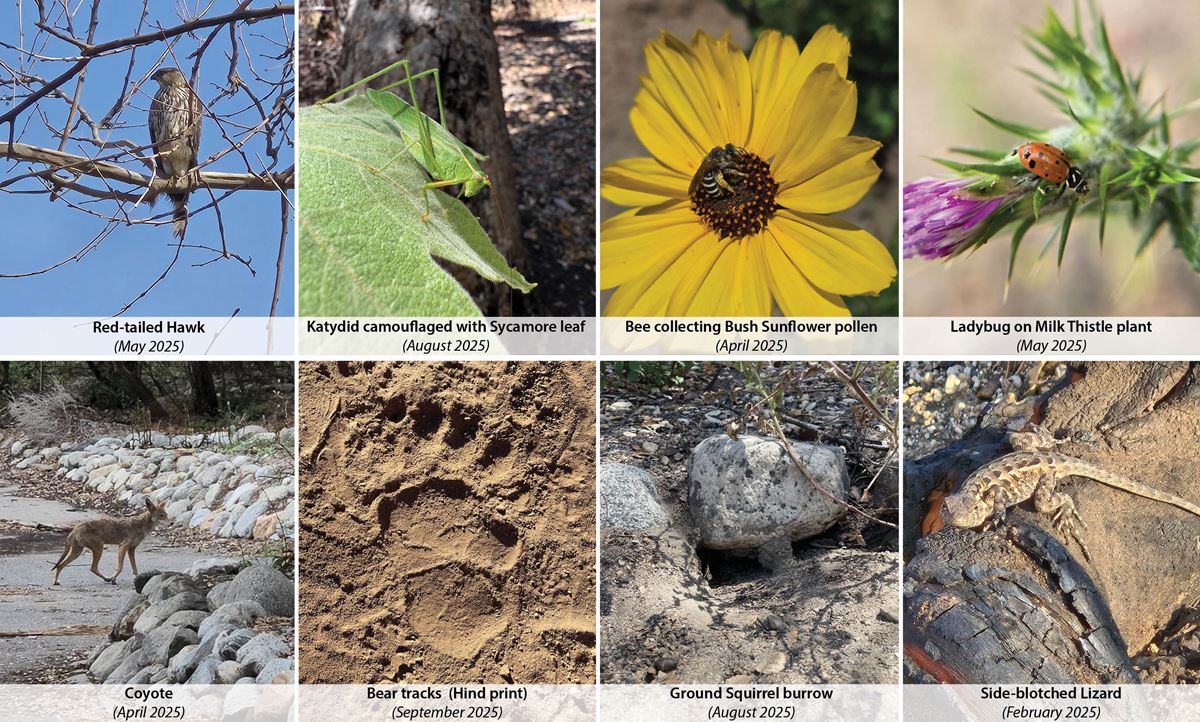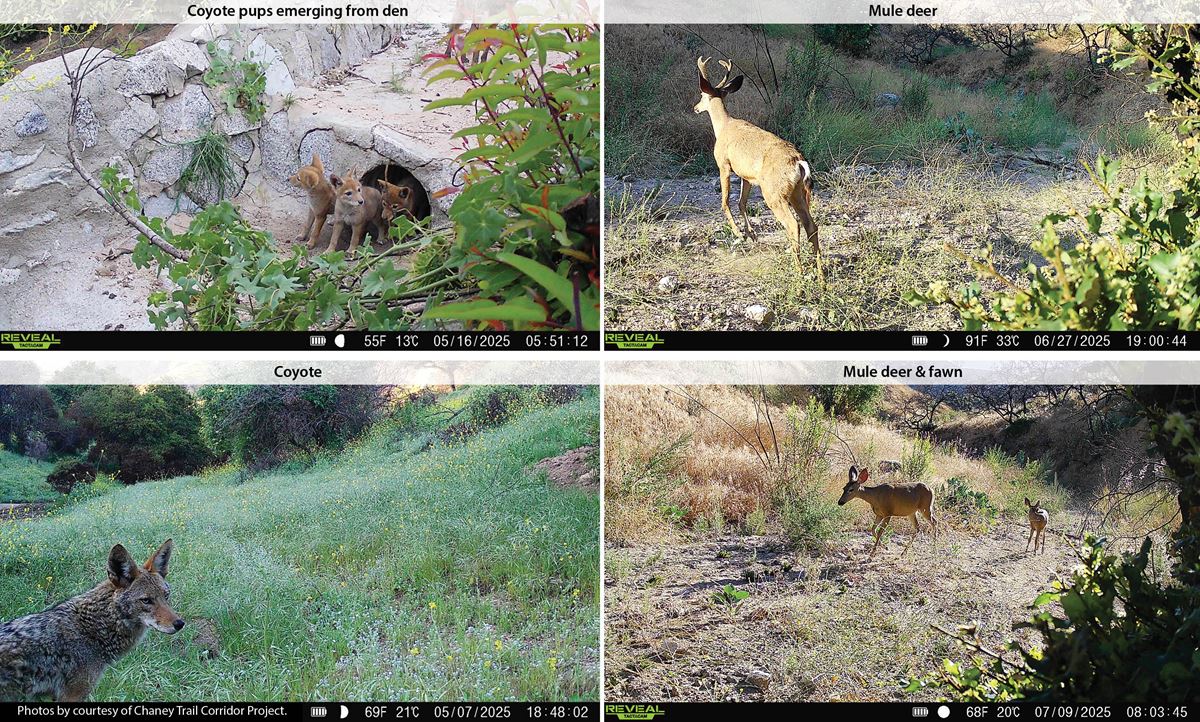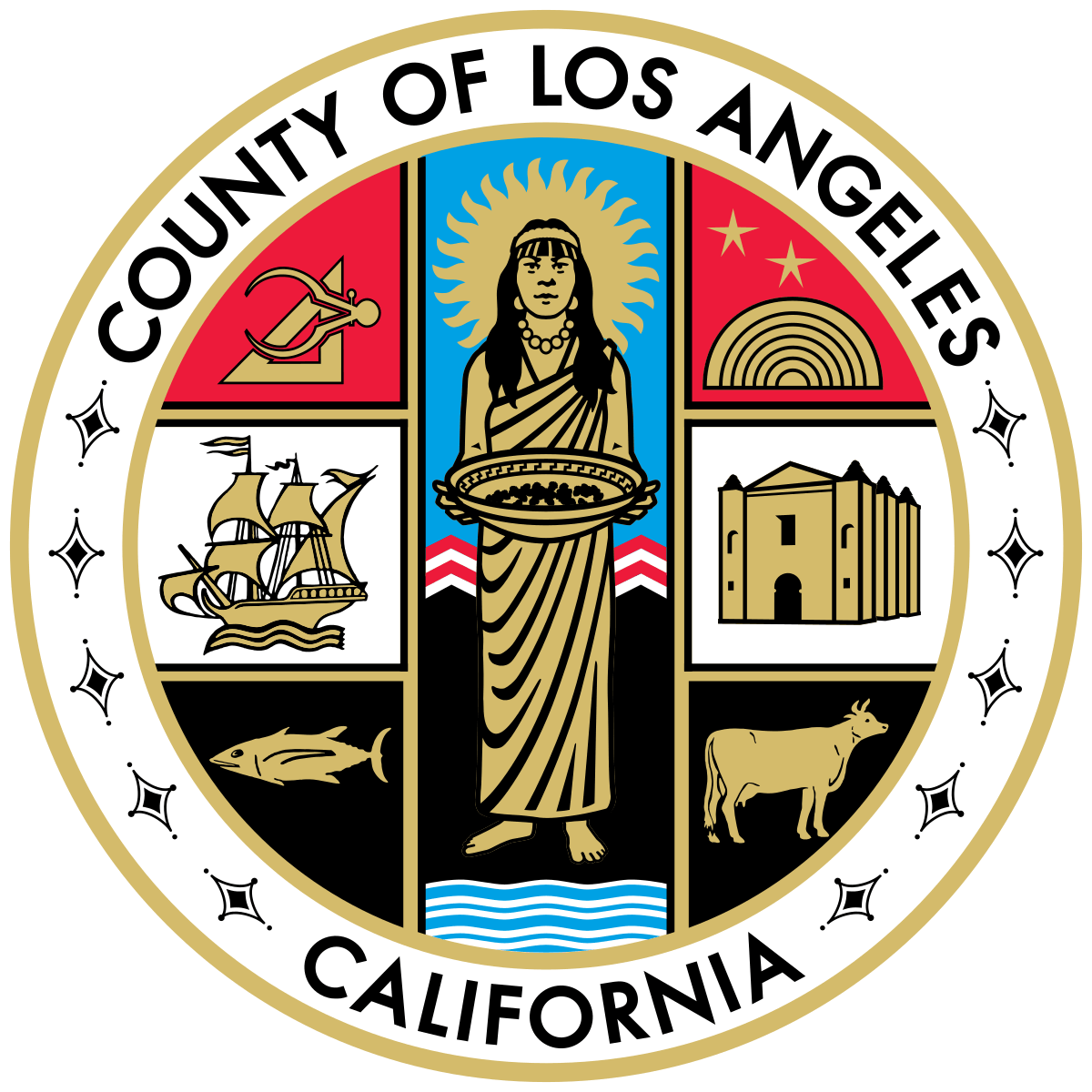Follow along the Journey to Eaton Canyon's Restoration
November 2025
Mule deer (Odocoileus hemionus) can be found in various climates, from the arctic landscapes of Alaska to the deserts of Texas. They have developed a range of behavioral and ecological adaptations that allow them to survive in continuously changing landscapes — such as Eaton Canyon.
Plant succession is the change in a plant community over time. Mule deer thrive in early plant successional stages where fire or other disturbances result in variety of grasses, forbs, and small shrubs. Without succession larger more competitive plants take up most of the available water and nutrients, leaving other smaller plants to struggle for survival. Following the Eaton Fire, early successional plants and green shoots beloved by mule deer and herbivores are popping up all over the canyon and the wash. Their return also signals a return of various wildlife back into the area.

Wildfires are a part of the Southern Californian landscape and are essential for mule deer habitats. Research suggests that deer populations respond positively to wildfire and result in increased body weights and increased fawn birth due to an abundance of food for deer populations (Sommer et al., 2007). Eaton Canyon is currently witnessing an abundance of mule deer, perhaps due to the plentiful amounts of plants growing in early successional stages.
Through a collaborative effort, the Eaton Canyon Nature Center Associates and LA County Parks recently launched the Eaton Canyon Natural Area Wildlife Movement Trail Camera Project. This initiative focuses on conserving wildlife corridors, promoting biodiversity, and public education on conservation efforts at Eaton Canyon. Wildlife movement trail cameras have been installed to document species presence, distribution, and seasonal movement patterns. The project also seeks to monitor fire recovery and habitat through education, interpretation, and public outreach.
“Though the park remains closed, our trail cameras often catch quiet moments of mule deer wandering through the recovering landscape. They are most often seen moving between the oak woodland, chaparral, and alluvial scrub habitats along the wash. These areas provide both cover and food, and the wash itself offers a reliable travel corridor through the canyon. They play a quiet but important role in the ecosystem, dispersing seeds and helping shape the vegetation structure through selective foraging,” shared LA County Parks Biologist, Cristhian Mace.

The mule deer buck observed at Eaton this Fall can tell us about Eaton Canyon’s recovery. This buck has large well-developed antlers and appears to be well-fed, suggesting that he is getting plenty of nutrients while feeding in the canyon. Diet is one of the most important factors in deer antler growth because it requires a large amount of nutrients, energy, and forage full of protein and minerals. You can roughly estimate the age of a buck by the number of points on the antlers. Typically, more robust and large antlers with various points suggest a mature age.
According to Kristen Ochoa, founder of the Chaney Trail Corridor Project, the buck that appears on the Eaton Canyon Trail camera seems to have reached an older age given the number of points on his antlers, “[...which means] he survived the fire and being able to re-grow those antlers and his general size, and healthy appearance, means that the ecosystem is returning and there is adequate food for him.”
Eaton Canyon is a wildlife corridor where so many wild animals traverse to complete their life cycles. Regardless —and sometimes because of wildfire disturbances — many species will return as the land continues to heal. Our wildlife trail cameras allow us to document how the fire has impacted the ecology of Eaton Canyon post fire. The canyon is still vulnerable and by respecting the closure and staying out of the natural area and off trails, the public helps ensure that Eaton Canyon can comeback as a biodiverse, fire-adapted landscape. You can support restoration and stewardship efforts by donating to the Eaton Fire Recovery — Los Angeles County Parks Foundation. Contributions help fund trail rebuilding, habitat recovery, signage, and educational programming.
Citation:
Sommer, Mary L., et al. Mule Deer Working Group, 2007, Habitat Guidelines for Mule Deer: California Woodland Chaparral Ecoregion.
September 2025
“In the eight months since the Eaton Fire, a whole host of wildlife have been spotted at Eaton Canyon. Pre-fire, the canyon demonstrated remarkable biodiversity, with patrons and staff regularly observing mule deer, coyotes, black bear, and even rare mountain lion sightings, along with a wide variety of birds, reptiles, and amphibians,” says Cristhian Mace, LA County Parks Biologist.

While wildfires pose immediate health concerns for humans and wildlife alike, surprisingly, there are few direct animal causalities due to the fire (Jolly et al., 2022). Many species have evolved over time and developed quick instincts to escape when a fire breaks out. Even if a burnt region seems empty to the naked eye, many species are either hidden underground, seeking refuge in the remaining foliage and trees, or are in a safe region nearby— ready to return once the flames have subsided.
Mace shares, “By the very next morning songbirds, raptors, and lizards were active, and in the months since, all the regular characters have been back. While ground squirrels, deer, and coyotes are easy to see, scat and tracks tell the rest of the story, with signs from bear, cottontail rabbits, reptiles, and birds showing up across the park, and delightfully on the trails around the former Nature Center.”


Kristen Ochoa, founder of the Chaney Trail Corridor Project, has been monitoring wildlife in the nearby Chaney Trail Corridor to document the biodiversity in the region. “It didn’t take long after the Eaton Fire for the animals and birds to return home. In the days that followed, coyotes watched from the bare ridges while ravens gathered on the blackened ground. In the canyon, birdsong grew denser than usual, and the area became a refuge, with water still flowing in the stream and much of the tree canopy spared. Deer came to drink, newts and tree frogs emerged, and spring—despite everything—brought pups and fawns," said Ochoa.

Plants in Eaton Canyon also play a huge role in the recovery and return of animals. Studies show that some pollinators can respond positively to recently burned meadows and nearly all species benefit from the floral richness that follows a wildfire (Jolly et al., 2022).
“Monarch butterflies are using the wash as a flyway, pollinators are out in force, and both day and night bring encounters with everything from southern Pacific rattlesnakes and tarantula hawks to western toads, scorpions, and bat species including myotis and canyon bats. The legacy of biodiversity at Eaton Canyon remains strong," emphasized Mace.
Eaton Canyon is a wildlife corridor that has adapted to withstand fire and flooding over time. However, it is still vulnerable in its recovery especially along trails and fire-scared slopes. Animals are also finding food and shelter and need time to do so without human interference. By respecting the closure and staying out of the natural area and off trails, the public helps ensure that Eaton Canyon can comeback as a biodiverse, fire-adapted landscape. The photos above document site conditions this summer. You can support restoration and stewardship efforts by donating to the Eaton Fire Recovery — Los Angeles County Parks Foundation. Contributions help fund trail rebuilding, habitat recovery, signage, and educational programming.
Citation:
Jolly, C. J., Dickman, C. R., Doherty, T. S., van Eeden, L. M., Geary, W. L., Legge, S. M., Woinarski, J. C., & Nimmo, D. G. (2022). Animal mortality during fire. Global Change Biology, 28(6), 2053–2065. https://doi.org/10.1111/gcb.16044
August 2025
August marked seven months since Eaton Fire burned across the San Gabriel Mountains and into the foothill communities of Altadena and Pasadena. The closing of the canyon to the public has minimized human disturbance and allowed the flora and fauna to recover and thrive after the blaze. This resurgence is largely due to the resiliency of the landscape and the presence of fire followers — plants that grow soon after a fire. Fire followers have seeds with very sturdy shells that need to be damaged for the plant to sprout, a process that is called scarification.
Fires can also change how plants compete for resources. Where trees are plentiful, light can be a limited resource for plants below the canopy. After a fire, the absence of shade from trees and large shrubs allows annual wildflowers to grow larger and more vigorously within the first few years after a fire.
Below are some fire followers that are currently blossoming at Eaton Canyon:
Mariposa Lily
Some species of mariposa lilies are considered fire followers as they tend to bloom far more frequently in the years immediately following a wildfire.
Poodle-Dog Bush
Named for its resemblance to the curly-haired canine, this seemingly innocent-looking plant can produce a painful rash for people who touch it (beware). The plant’s seeds can be dormant for years until a fire induces germination. Once the plant dies, it typically will not be seen again until the next burn.
Short Lobed Phacelia
The short lobed phacelia (Phacelia brachyloba) can be found all over southern California and northern Mexico: along the coast, valleys, and canyons. It is typically one of the first flowers that appear in recently burned areas.
Large Flowered Phacelia
Large flowered phacelia (Phacelia grandiflora) grows in coastal sage scrub and chaparral in southern California and Baja California. It grows abundantly in recently scorched regions by wildfires.




The growth at Eaton Canyon is still vulnerable to trampling, erosion, or soil compaction—especially along informal trails or fire-scarred slopes. Non-native species such as shortpod mustard are spreading aggressively in some areas and shoes and dogs can unintentionally carry and spread seeds, exasperating the issue. By respecting the closure and staying out of the natural area and off trails, the public helps ensure that Eaton Canyon can comeback as a biodiverse, fire-adapted landscape. The photos above and video below document site conditions in August 2025. You can support restoration and stewardship efforts by donating to the Eaton Fire Recovery — Los Angeles County Parks Foundation. Contributions help fund trail rebuilding, habitat recovery, signage, and educational programming.




